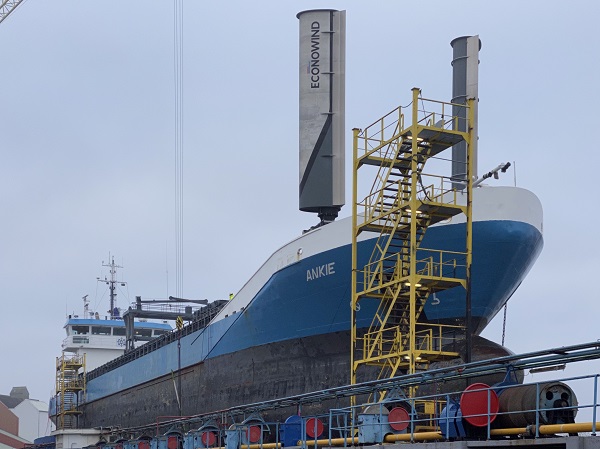eConowind Solution Readies for Sea Trials
The Dutch engineering firm eConowind BV has finished land-testing its foldable, autonomous wind system and is readying it for sea trials.
A full-size eConowind system will be tested in the North Sea and Baltic on MV Lady Christina operated by WijnneBarends Delfzijl. Two units will be installed in a 40-foot container mounted on the hatchcovers. From there, with a button push in the bridge, the VentiFoils can be folded out to act like sails. They will automatically adjust to the direction of the wind to generate maximum thrust.
eConowind expects to start commercial production and delivery of the system in the second quarter of 2019.

eConowind is a member of the International Windship Association (IWSA) which has been holding a series of events in Northern Germany to help galvanize the development of a regional wind propulsion hub, IWSA Europe North Sea & Baltic. The hub will be formed in the coming months around a core of wind propulsion projects from the Netherlands, Germany and Scandinavia with the aim of sharing best practice and working together to further help develop, promote and ultimately build wind assist and primary wind vessels.
Th group held meetings at Hochschule Emden Leer and the Hamburg School of Business Administration to help plot the course. In attendance were eConowind (NL), Norsepower (FIN), Blue Technology (DK), Ecoflettner (DE), to R&D, Designers & Naval Architects including: MARIN (NL), MARIKO & MariGreen project (DE), Utopia Navalis (DE), Dykstra NA (NL) and IDMM (NL).
Earlier this month, Norsepower announced that it has concluded its equity financing round, raising €3.6million ($4.1 million) in funding to drive the company’s expansion and growth plans. With the funds raised, Norsepower, whose customer’s include Maersk Tankers, Viking, Line and Bore, will be able to expand production of its Rotor Sails in Asia, as well as ramp-up its search for potential supplier partners within the region.
The Norsepower Rotor Sail Solution is a modernized version of the Flettner rotor, a spinning cylinder that uses the Magnus effect to harness wind energy and propel ships. The solution, which is suitable for both newbuilds and retrofitting, has the ability to deliver fuel and emissions savings of up to 20 percent when wind conditions are favorable.
Over the last year, Norsepower has celebrated a number of successes, including the installation of its Rotor Sail technology onboard Viking Line’s M/S Viking Grace in April 2018, making her the first passenger ship in the world using auxiliary wind propulsion. Separately, in partnership with Maersk, Shell, and the U.K.’s Energy Technologies Institute, a Maersk P-class 109,647dwt oil product tanker was retrofitted with two 30-meter tall by five-meter diameter Norsepower Rotor Sails at the end of August 2018.
“The way forward is full of exciting opportunities,” said Gavin Allwright, IWSA Secretary General. “These activities follow some of the recommendations made in the E.U. report on wind propulsion market development, which forecast up to 10,700 wind propulsion installations on bulkers and tankers by 2030 if the facilitation framework is in place. The development of this North Sea and Baltic Hub is one step in the right direction.”
Wind Propulsion Technologies break down into seven main categories, with all technologies being fully automated in operation for ease of use, safety and efficiency:
• Soft Sail – both traditional sail and new designs of dynarig etc.
• Hard Sail – wingsails, foils etc. Some rigs have solar panels for added ancillary power generation.
• Flettner Rotor (Rotor Sail) – rotating cylinders operated by low power motors using the Magnus effect (difference in air pressure on different sides of a spinning object) to generate thrust
• Suction Wings (Ventifoil, Turbosail) – non-rotating wing with vents and internal fan (or other device) that use boundary layer suction for maximum effect.
• Kites – dynamic or passive kites off the bow of the vessel to assist propulsion or to generate a mixture of thrust and electrical energy.
• Turbines – using marine adapted wind turbines to either generate electrical energy or a combination of electrical energy and thrust.
• Hull Form – the redesign of ship’s hulls to capture the power of the wind to generate thrust.
